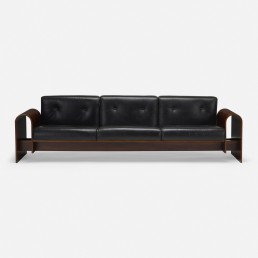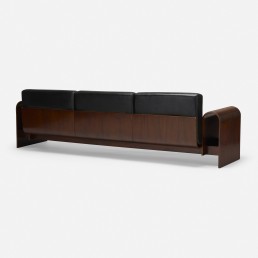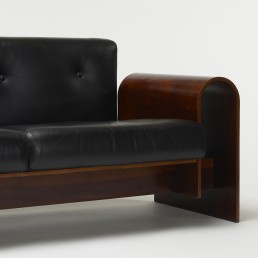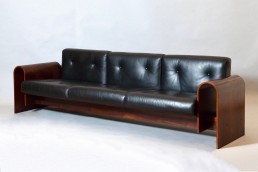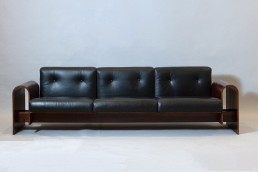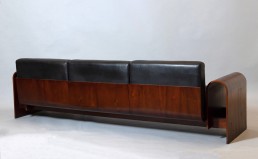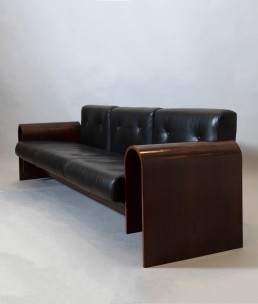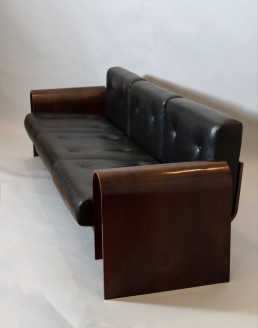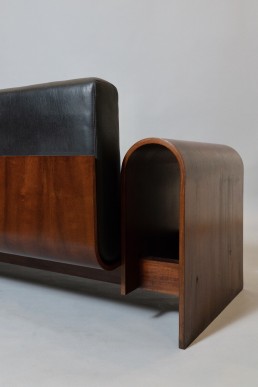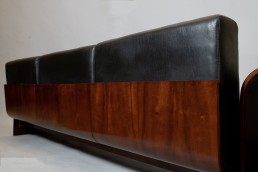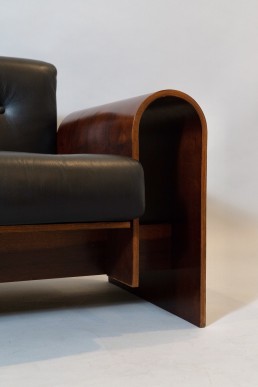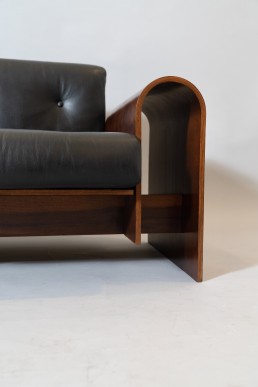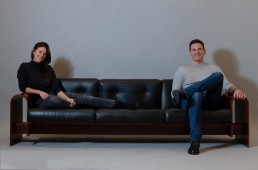Oscar Niemeyer: Exceptional Sofa in Rosewood and Leather, Hotel SESC, Brazil 1990
Oscar Niemeyer (1907 – 2012)
A rare, three-seat sofa by Oscar Niemeyer for the SESC Hotel Copacabana in Rio de Janeiro; in Brazilian rosewood with black leather cushions. A model of modernist sensuality that makes remarkable use of Niemeyer’s distinct vocabulary of soaring forms and flowing lines, this generously proportioned work features beautifully curved waterfall arms of singular purity, buoying a straight-edged body and suspended frame. The rounded rosewood back, in which nestle three large cushions, echoes the arch of the arms. Despite its majestic size, the piece seems to float: Only half of each arm touches the ground, conveying an impression of lightness, simplicity, and grace typical of Niemeyer’s curvilinear structures.
At the same time, the sofa’s ample proportions and comfortable cushions invite the sitter to linger in free-flowing conversation — a poetic adjustment of the architect’s vocabulary into a domestic setting.
A committed socialist, Niemeyer was devoted, in his own words, to “making this unjust world a better place in which to live,” through both activism and architecture. This sofa is part of his design for the 1990 SESC Hotel Copacabana, a project of the Serviço Social do Comércio, a social services organization established in the 1940’s by Carioca trade groups, for which Niemeyer designed both the building and original furnishings.
Like Le Corbusier, with whom he collaborated in his early years, Brazil’s greatest architect well understood how to bring structural lightness to designs both monumental and private. But alongside other pioneers of Brazilian modernism like Sergio Rodrigues and Joaquim Tenreiro, he also incorporated what he considered a specifically Carioca joy and sense of place —evident here, for instance, in his use of parabolas, which echo the hills and waves of Rio. Coupled with a respect for native materials, they make his work inviting and distinct, infusing the sometimes dictatorial rationalism of modernism with a surprising sensuality.
Brazil, 1990.
- Origin: Brazil
- Period: 1990
- Dimensions: 98’’ L x 30’’ D x 29’’ H
- Materials: Rosewood, leather
- Condition: Very good; wear consistent with age and use
Product Description
couch, sofa, settee
A model of modernist sensuality and soaring forms/ in the architect’s distinctly soaring forms, vocabulary of soaring conjugated in/ configured in this large couch features beautifully curved waterfall arms of singular purity buoying a suspended frame.
A model of modernist sensuality and soaring forms/ in the architect’s distinctly soaring forms, that makes exceptional use of the architect’s vocabulary of distinctly soaring forms and flowing lines, conjugated in/ configured elaborated in the architect’s distinctly soaring forms and flowing lines, this large couch features beautifully curved waterfall arms of singular purity buoying a suspended frame. The arms extend seamlessly to the ground as the two visible points of contact so the rest of the piece seems to float, giving an impression of lightness, simplicity, and grace typical of Niemeyer’s curved and soaring structures.
the second half of the arch intersecting with the seat and never touching the ground.
as half of each arch forms one of the the two sole points of contact with , One half of each arched arm extends seamlessly to the ground to form the only two visible points of contact, The arched arms extend seamlessly to the ground on as the two visible points of contact so the rest of the piece seems to float, giving an impression of lightness, simplicity, and grace typical of Niemeyer’s curved and soaring structures.
At the same time, the sofa’s generous proportions and welcoming, oversized cushions invite conversation and intimacy
Like Le Corbusier, with whom he collaborated in his early years, Brazil’s greatest architect understood how to bring a structural lightness to designs both monumental and private. But alongside other pioneers of Brazilian modernism like Sergio Rodrigues and Joaquim Tenreiro, he also incorporated a Carioca sense of play, joy, and comfort, as well as a respect for native materials
and through him Niemeyer would absorb many lessons in bringing a sense of structural lightness to large buildings
This sofa is part of Niemeyer’s original design for the SESC Hotel Copacabana, a project of run by the Serviço Social do Comércio, a social services non-profit established in the 1940’s by Rio’s tradesmen and tourism professionals
A committed socialist, Niemeyer was devoted to TK and said TK. He lent his talents
A long-standing socialist, Niemeyer was committed to This sofa is part of his original design for the SESC Hotel Copacabana, a project of the social services non-profit Serviço Social do Comércio, established in the 1940’s by Rio’s tradesmen and a biz org devoted to social improvement
a project of the Serviço Social do Comércio, a business organization established in the
humanitarian services organization established in the 1940’s by Rio’s business groups.
the social services non-profit Serviço Social do Comércio, established in the 1940’s by Rio’s tradesmen and a biz org devoted to social improvement
a project of the Serviço Social do Comércio, a business organization established in the
for the Designed for the hotel of the Serviço Social do Comércio, a social services non-profit established in the 1940’s by Rio’s tradesmen and tourism professionals, the sofa
humanitarian services organization established in the 1940’s by Rio’s tradesmen.
This sofa is part of Niemeyer’s original design for the SESC Hotel Copacabana, a project of run by the Serviço Social do Comércio, a social services non-profit established in the 1940’s by Rio’s tradesmen and tourism professionals
chamber of commerce
beneficient organization of tradesmen
chamber of commerce
beneficient organization of tradesmen
Oscar Niemeyer
Jorge Zalszupin
Joaquim Tenreiro
Isay Weinfeld
Sérgio Rodrigues
José Zanine Caldas
Zanini de Zanine
le corbusier
Oscar Niemeyer (1907 – 2012)
An exceptional and rare original three-seat sofa by Oscar Niemeyer for the SESC Hotel Copacabana in Rio de Janeiro, in Brazilian rosewood with black leather cushions. A model of modernist sensuality that makes remarkable use of Niemeyer’s distinct vocabulary of soaring forms and flowing lines, this generous couch features beautifully curved waterfall arms of singular purity buoying a straight-edged body and suspended frame. The beautifully curved rosewood back, in which comfortably nestle three large leather cushions, echoes the arch of the arms. Despite its size, the piece seems to float: only half of each arch touches the ground, conveying an impression of lightness, simplicity, and grace typical of Niemeyer’s curved and soaring structures.
At the same time, the sofa’s generous proportions and welcoming, oversized cushions invite lounging, lingering, and free-flowing conversation, a poetic adjustment of the architect’s vocabulary into a domestic setting.
A committed socialist, Niemeyer was devoted, in his own words, to “making this unjust world a better place in which to live” through both activism and architecture. This sofa is part of his original design for the SESC Hotel Copacabana, a project of the Serviço Social do Comércio, a social services organization established in the 1940’s by Carioca trade groups, for which Niemeyer designed both the building and its original furnishings.
Like Le Corbusier, with whom he collaborated in his early years, Brazil’s greatest architect understood how to bring a structural lightness to designs both monumental and private. But alongside other pioneers of Brazilian modernism like Sergio Rodrigues and Joaquim Tenreiro, he also incorporated a Carioca sense of play, joy, and comfort —evident, for instance, in his use of parabolas, which echo the hills and waves surrounding Rio. Coupled with a respect for native materials, they make his work inviting and distinct, infusing the somewhat dictatorial rationalism of modernism with a surprising sensuality.
Brazil, 1990


